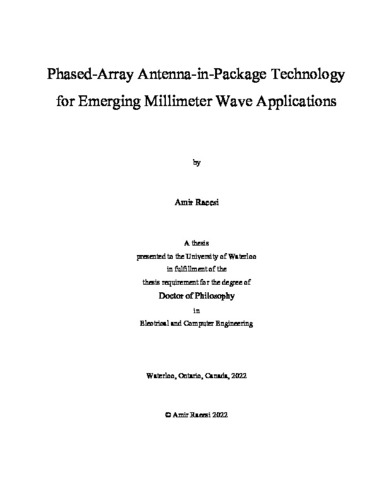| dc.description.abstract | The ever-increasing data rates for wireless technologies (e.g., satellite communications, fifth generation (5G) wireless communications, and automotive radars) has directed the interests towards millimeter wave (mm-Wave) technology that provides wider absolute bandwidth. Relatively small size of antennas at mm-Wave makes large-scale phased-array antenna (PAA) system a feasible solution to compensate for the path loss and alleviate the requirements of the RF transceiver front-ends at mm-Wave.
Despite developments in the military applications for more than 50 years, active PAA systems have been costly for commercial applications. The high cost is mainly due to the discrete implementation of transmit/receive beamforming modules where III-V front-end monolithic microwave integrated circuits (MMICs) (GaAs or InP, or both) are assembled together with silicon-based chips used for address decoders, power management, and general digital control such as phase and gain setting and calibration. A paradigm shift happened when silicon-based phased arrays had been implemented starting with the work at Caltech using silicon-germanium (SiGe) bipolar CMOS (BiCMOS) and Si CMOS technologies. Silicon-based technologies (Si-CMOS and SiGe-BiCMOS) are not costly and are able to be produced in a large scale. On the other side, multilayer antenna-in-package (AiP) technology is currently the prevailing antenna and packaging technology for miscellaneous mm-Wave applications. These two technologies together make low-cost, low-power active PAA possible. A modular and scalable silicon-based phased-array AiP could be the building block for the development of large-scale mm-Wave PAA systems where hundreds to thousands of antenna elements are required in order to provide a reliable communication link. This approach not only ease the complexity of the system, but also makes the implementation of the system over any conformal geometry feasible.
In this thesis, two different architectures for phased-array AiP are presented. The first architecture is a 4×4 active transmit phased-array AiP with polarization control at Ka-band. The second architecture is a 4×4 bi-directional antenna array with integrated passive beamformer with left-handed circular polarization (LHCP) radiation.
In chapter II, a 4×4 active transmit phased-array AiP with polarization control at Ka-band is discussed. Silicon-based active transmit phased-array AiP is able to realize any kind of polarization including linear and circular polarization besides providing relatively high effective isotropic radiated power (EIRP). The proposed active AiP is modular and scalable and is able to be employed as the unit cell for a large-scale phased-array antenna system. It consists of 16 dual- linearly polarized cavity-backed patch antennas, four 8-channel active beamformers, and a four-way splitter network. The proposed AiP provides 42 dB of active gain at the boresight. The (EIRP) of the current module is 41 dBm at the 1-dB compression point of the active beamformer chips and it consumes 2.6 W of DC power when the system radiates left-handed circular polarization at the boresight. Calibration and radiation pattern measurement of the system is also discussed and the measurement results for a case of left-handed circularly polarized (LHCP) radiation is presented.
In chapter III, a 4×4 bi-directional antenna array with integrated passive beamformer with left-handed circular polarization (LHCP) radiation is presented. Hybrid approach that combines active and passive PAA architectures is an alternative solution in lowering the cost and complexity of active PAA systems. The design and implementation aspects of a 4×4 antenna array with integrated passive beamformer for low-cost and efficient millimeter wave applications is presented. The phase shifter’s operational principle and actuation mechanism are discussed in detail. Slow-wave structure is employed to shrink the size of the phase shifter. The simulation and measurement results of the phase shifter are presented. Measurement results show the maximum insertion loss of 2.2 dB in all the tuning states and the insertion loss variation is 1.2 dB. Also, it provides 380º of the phase tuning range in a compact footprint area of 2.4 mm × 3 mm. 2D P-PAA is designed, simulated and measured over the operating band. Measurement results show the antenna‘s main beam can be steered over an angular range of ±30º in both elevation and azimuth planes.. The operating frequency bandwidth of the system ranges from 28-30 GHz. The antenna’s main characteristics, such as radiation pattern, directivity, efficiency, and reflection coefficient are measured and presented. | en |

